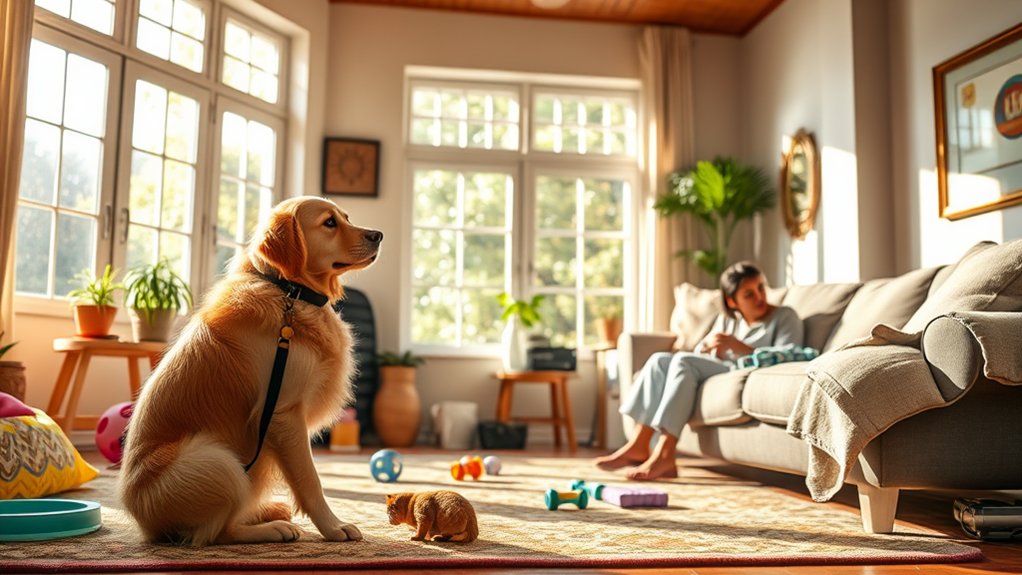What’s the Difference Between Pet Training and Behavioral Therapy After Moving? Which Does Your Pet Need?

Pet training and behavioral therapy serve different purposes, especially after moving. Training focuses on teaching basic commands and obedience skills through repetition and positive reinforcement. It's ideal if your pet needs help with simple behaviors. Conversely, behavioral therapy addresses emotional and psychological issues like anxiety or aggression. This approach involves tailored plans for deeper challenges, especially after environmental changes. Assess your pet's needs carefully. If you notice excessive barking or signs of stress, professional help may be necessary. Understanding these distinctions is crucial to guarantee your pet adjusts well, and there's more to evaluate for effective solutions.
Understanding Pet Training

When you think about pet training, it's important to understand that it's all about teaching your dog essential skills and commands. This training helps dogs navigate human environments safely and understand household rules. Common training methods include group classes, private sessions, and online forums, emphasizing positive reinforcement techniques. These methods encourage desired behaviors and prevent behavioral issues from arising. A qualified dog behaviorist usually leads training, ensuring they have the necessary education and certification. Their knowledge spans various specialties like obedience and agility. As a dog owner, your active participation is vital. Engaging in the training process reinforces learned behaviors and helps address any issues that may come up, fostering a harmonious living environment for both you and your dog.
Exploring Behavioral Therapy
While pet training focuses on teaching commands and skills, behavioral therapy addresses deeper emotional and psychological challenges your pet may face. This type of therapy targets underlying causes of issues like anxiety, aggression, and phobias. A qualified professional, such as a Clinical Animal Behaviourist, develops a tailored training plan that considers your pet's unique history and environment. Techniques like desensitization and counter-conditioning are often used to help your pet adapt to new situations, such as moving to a new home. Behavior modification through therapy typically takes time and consistency to achieve lasting results. Collaboration between you and the behaviorist is essential, as your involvement and understanding of your pet's cues can greatly enhance the therapy's effectiveness.
Key Differences Between Training and Therapy

Understanding the key differences between pet training and behavioral therapy can help you choose the best approach for your furry friend. Training focuses on teaching obedience skills and commands, while behavioral therapy addresses deeper emotional or psychological issues after a move. Dog trainers typically work on observable behaviors, like jumping on guests, using methods like positive reinforcement. In contrast, behavioral therapy involves a tailored modification plan developed by a clinical animal behaviorist. This approach is vital for serious behavior issues, such as aggression or anxiety. While training may suffice for basic obedience, behavioral therapy is necessary for understanding and resolving your pet's emotional triggers. Recognizing these differences is essential for your pet's well-being.
Identifying Your Pet's Needs
To identify your pet's needs, start by evaluating any behavioral concerns they may show, like excessive barking or signs of anxiety. Next, recognize any gaps in their training that could contribute to these issues. Finally, assess any environmental stressors, such as recent moves, that might be affecting their behavior.
Assessing Behavioral Concerns
How do you know if your pet needs behavioral therapy? After moving, you might notice changes in your dog's behavior, such as anxiety or aggression. These signs often indicate stress from the new environment and may require a tailored behavioral therapy plan. Observing your pet's body language, like cowering or pacing, can reveal their emotional state, helping you assess their needs. Maladaptive behaviors like excessive barking or destructive chewing signal underlying issues that basic training won't address. Early intervention is vital; addressing these concerns promptly can prevent escalation. Consulting a qualified behavior expert can help you create an effective training plan focused on your pet's specific behavioral needs, ensuring they adjust well to their new home.
Recognizing Training Gaps
Recognizing training gaps in your pet's behavior is essential, especially after a significant change like a move. You should observe your pet closely in their new environment. Look for specific obedience skills they may lack, like sit or stay. Changes can trigger issues, such as anxiety or aggression, indicating a need for behavioral therapy instead of just dog training.
| Signs of Training Gaps | Suggested Action |
|---|---|
| Difficulties in leash walking | Structured dog training |
| Jumping on guests | Basic obedience commands |
| Frequent distractions | Focused training sessions |
| Reacting to unfamiliar noises | Behavior consultant advice |
| Aggressive behavior | Behavioral therapy sessions |
Evaluating Environmental Stressors
After identifying training gaps, it's important to contemplate the role of environmental stressors in your pet's behavior. When you move, unfamiliar sounds, smells, and routines can stress your pet, leading to maladaptive behaviors like barking or hiding. Analyzing environmental stressors is vital for understanding these changes. You should monitor your pet's body language and stress signals, such as panting or pacing. This can help you recognize when they need behavioral therapy rather than basic training. Providing a consistent routine and safe spaces can ease their adjustment. Consulting a qualified animal behaviorist can be beneficial in evaluating your pet's needs and developing a tailored plan to address any behavioral issues stemming from these environmental changes.
When to Seek Professional Help

When your pet starts showing signs of stress or behavioral issues, it's important to contemplate seeking professional help. If you notice maladaptive behaviors like excessive barking, destructive chewing, or refusal to eat, these may indicate deeper emotional problems. In such cases, behavioral therapy can be more effective than standard training. A clinical animal behaviorist can create a specific training plan tailored to your pet's needs, focusing on their unique challenges. If your pet struggles with separation anxiety or fear of new environments, prompt intervention is essential. Seeking professional help early can prevent further escalation of issues and support a smoother adjustment period for your pet after moving. Don't hesitate to reach out for assistance when you see concerning signs.
Common Behavioral Issues After Moving
Moving to a new home can trigger a variety of behavioral issues in pets, often stemming from stress and unfamiliar surroundings. You might notice increased anxiety, aggression, or socialization issues as your pet adjusts. Common problems include separation anxiety, where pets may chew furniture or bark excessively when left alone. Changes in their territory can lead to fear responses, causing hiding or refusal to eat. Unfamiliar scents can also make pets reluctant to explore their new environment. Here's a breakdown of common behavioral issues:
| Behavioral Issue | Description | Potential Signs |
|---|---|---|
| Anxiety | Stress from new surroundings | Excessive barking, hiding |
| Aggression | Fear or territorial disputes | Growling, snapping |
| Socialization Issues | Reactivity towards new animals or people | Fearful behavior, avoidance |
| Separation Anxiety | Distress when left alone | Destructive behavior, whining |
Choosing the Right Approach

How can you determine the best approach for your pet's adjustment issues? Start by evaluating whether your pet displays obedience challenges or emotional issues. If your pet struggles with anxiety or aggression after moving, behavioral therapy is likely the most effective solution. This focuses on their emotional well-being rather than just obedience. On the other hand, if your pet needs to learn basic commands, hiring a dog trainer might be appropriate. It's also beneficial to collaborate with both trainers and behaviorists. A thorough training plan can address obedience while a behaviorist tackles deeper emotional concerns. Make sure to research professionals carefully, as behaviorists have advanced training in animal psychology compared to standard dog trainers.
Frequently Asked Questions
Do I Need a Dog Trainer or Behaviourist?
You need to assess your dog's behavioral signs. If it's obedience issues, dog training methods work. For pet anxiety or deeper issues, consider a behaviorist. Understanding your responsibilities helps you choose the right training techniques.
What Is the Difference Between a Dog Trainer and a Behaviorist?
Dog trainers utilize dynamic dog training techniques to teach commands, while behaviorists boast behavioral qualifications, addressing deeper issues. Understanding canine behavior and fostering a strong trainer-client relationship helps you choose the best approach for your pet.
What Is the Difference Between Behavior Training and Obedience Training?
Obedience training focuses on commands using techniques that shape behavior, while behavior modification addresses deeper issues through understanding pet psychology. Each training method caters to different learning styles, ensuring your pet develops positively in various situations.
When Should a Dog See a Behaviorist?
When your dog shows anxiety, fear aggression, or socialization issues, it's time to consult a behaviorist. If you notice separation anxiety or struggles with post-move adjustment, professional guidance can help restore balance and happiness.
Conclusion
In summary, understanding the distinction between pet training and behavioral therapy is essential after a move. Training focuses on teaching commands and skills, while therapy addresses deeper behavioral issues. Recognizing your pet's specific needs helps you decide the best approach. If your pet struggles with stress or anxiety, seeking professional help can lead to successful solutions. By making informed choices, you can support your furry friend in adjusting to their new environment and enjoy a happier home together.
Related posts
Recent posts
Post Categories
Tags
Subscribe




